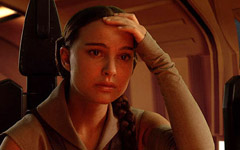
| HOME |
| NERVE |
| REVIEWS |
| ARCHIVE |
| EVENTS |
| LINKS |
| ABOUT US |
| CONTRIBUTORS |
| BACK ISSUES |
| CONTACT US |
 Star
Wars Episode III – Revenge of the Sith (12A)
Star
Wars Episode III – Revenge of the Sith (12A)
On general release from 19th May
Directed by George Lucas
Reviewed by Tim Kopp
Charting Anakin Skywalker’s tragic turn to the dark side of the force, the final Star Wars prequel Revenge of the Sith is decidedly hit-and-miss in many respects. Still, after the massively disappointing first two episodes, it qualifies as a partial return to form, thanks to a stirring second half and strong performances from Ian McDiarmid and Ewan MacGregor. *** out of five
The clone wars that marked the end of Episode II – Attack of the Clones continue. Jedi knights Obi-Wan Kenobi and Anakin Skywalker and the robot R2-D2 are on a mission to rescue the Republic’s Chancellor Palpatine who has been kidnapped by the droid armies’ new leader General Grievous under the command of Sith lord Count Dooku. Anakin defeats Dooku in the ensuing battle and brings Palpatine to safety. On his return, Padme tells Anakin that she is pregnant while the Jedi Council instigates a search for Grievous who has managed to escape. Plagued by nightmares about Padme’s death in childbirth and frustrated by the council’s lack of trust in him, Anakin turns to the chancellor. Seizing on Anakin’s torn emotions and desire to do good, Palpatine hints at the power of the dark side of the force. This has tragic consequences for Anakin and the Republic at large.
Episode III begins strongly with a meticulously realised and well-paced space battle that evokes memories of equivalent scenes in A New Hope and Return of the Jedi, with ship design reminiscent of the original trilogy, suggesting early prototypes of the X-Wing fighters and the Star Destroyer. Sustained momentum apart, Lucas also proves more adept at combining suspense with a light touch than in the earlier prequels as R2-D2 provides good comic relief in the early stages. Christopher Lee makes the most of a regrettably brief appearance before the film settles into a slower pace for the continuing love story between Anakin and Padme, the politics of the council and Palpatine’s subtle attempts to manipulate Anakin into exploring and using all facets of the force. The intercutting between the three storylines produces uneven results: the council debates and the romance between Padme and Anakin, while no longer as insufferable as in Attack of the Clones, still rank among the film’s least engaging scenes though one wonders what the fans will make of Episode III’s political commentary, a thinly veiled criticism of the Bush administration’s foray into Iraq.
In contrast, Palpatine’s scheming against the Republic and his skilful exploitation of Anakin’s fears provide the material for some of the film’s most powerful moments: Ian McDiarmid is exceptionally good as the devious Chancellor (less so when Palpatine turns into the disfigured Darth Sidious, nonetheless McDiarmid is worth the price of admission alone), but equally importantly, Lucas by and large convincingly defines and develops Anakin’s internal conflict. That his love to Padme ultimately compels him to use the dark side of the force feels plausible and it works in practice although it doesn’t have the stronger impact and weight it would have had if Lucas had told this romance with greater skill and conviction. He partially compensates for this in the way key scenes in Episode III enhance and change the meaning of scenes from the original trilogy: the duel between Anakin and Obi-Wan adds even more weight to their meeting in A New Hope while Palpatine’s manipulation of Anakin forebodes and parallels the Emperor’s temptation of Luke in Return of the Jedi.
Other aspects of the film are – again - lacking: Padme’s character is given little to do here other than to react, and her story is resolved in a rather unsatisfactory fashion. As in the first two prequels, Lucas inserts extraneous scenes that only interrupt the film’s flow and take away valuable time from the real story. In that context, Chewbacca’s cameo and the fleeting battle scenes involving Wookies could have been saved for the forthcoming DVD. The space battles and fights on the ground are always entertaining but some of the most anticipated sequences surprisingly lack the extra punch: Anakin’s early fight against Count Dooku and Obi-Wan’s standoff with Grievous are altogether more involving than Mace Windu’s clash with Palpatine. Obi-Wan’s final confrontation with Anakin works extremely well on an emotional level but the lightsabre duel in itself feels oddly anti-climatic after all the hype and promising build-up. The most poignant and moving moment arrives when, in a homage to James Whale’s Frankenstein, Anakin’s final metamorphosis into Darth Vader is complete: the effect of his appearance in the iconic mask and costume and the sound of James Earl Jones’ familiar voice is bound to send shivers down one’s spine. Episode III doesn’t salvage the prequel trilogy nor does it have the magic of The Empire Strikes Back and A New Hope (Return of the Jedi has always been overrated) but it is a respectable entry in the series and shows signs of being a lasting work.
Printer friendly page